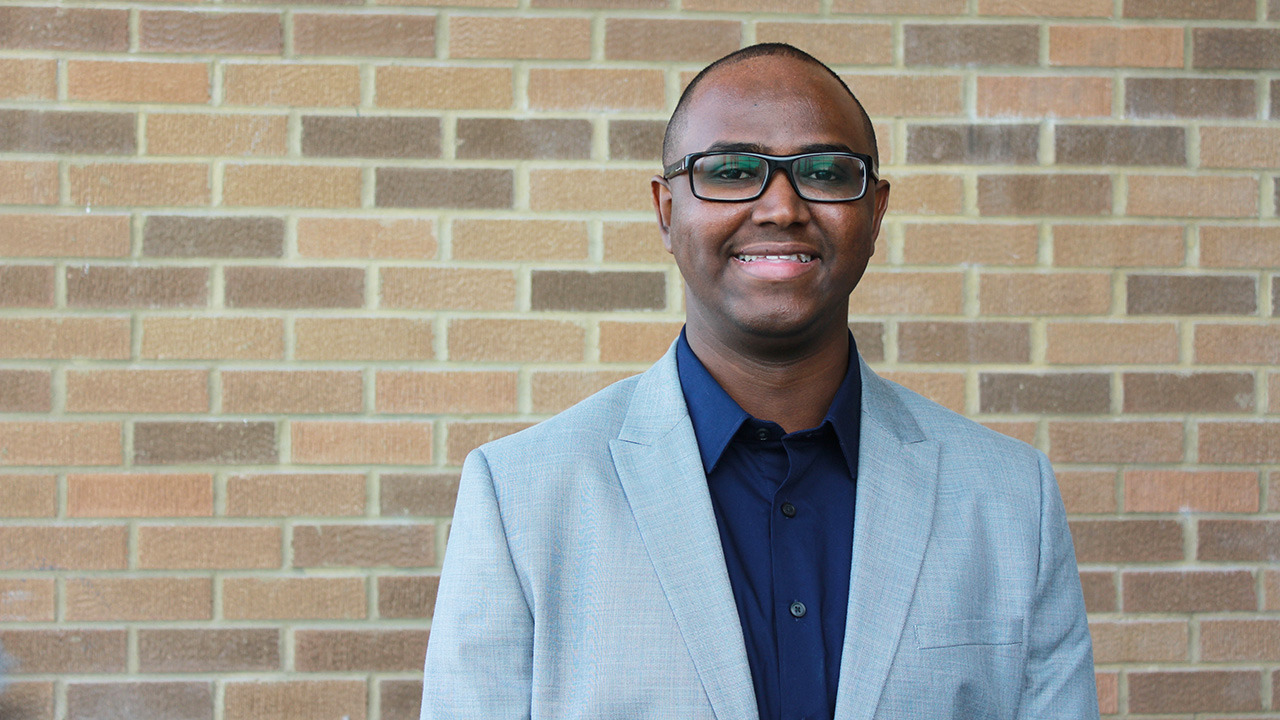In his element: PhD student finds calling in translational research
Abdikarim Abdullahi was driving home when his phone alerted him to a new email. Certain it was the notice he was eagerly awaiting, Abdullahi pulled into the nearest parking lot and opened the message.
It was good news: he had won a Vanier Canada Graduate Scholarship through the Canadian Institutes of Health Research.
“The first person I called was my brother,” says Abdullahi, a PhD student in the Institute of Medical Science at the University of Toronto who is training in the lab of Sunnybrook Research Institute (SRI) senior scientist Dr. Marc Jeschke. “He was the only family member who knew I applied. He was so happy and proud.”
The prestigious award, worth $150,000 over three years, meant more to him than simply funding to do his work. Of the roughly 200 students that U of T nominates for the Vanier scholarship, only one-quarter receive the honour. It recognizes not only academic excellence, but also leadership. Abdullahi, who has done extensive youth outreach for the city’s Somalian community, was ranked in the top 10th percentile of all U of T applicants. For someone who hadn’t planned on a career in research, the validation was huge.
“I would never in my wildest dreams have thought [I’d do] a PhD,” says Abdullahi. “All the times I doubted myself—Have I picked the right career? Am I behind?—this [award] solidified that this is the path I’m supposed to take.”
Ever since his first-year human physiology course, Abdullahi has wanted to become a doctor. He did a master of science degree in which he studied how muscle cells are differentiated to strengthen his medical school application. “I swore off grad school after my master’s. I was in a university basement working with cells every day. It was the same thing over and over again. It didn’t foster a passion for research.”
He thought clinical research would round out his med school application so he worked part-time as a research assistant for Dr. Jacques Lee, who specializes in emergency medicine at Sunnybrook and is a scientist at SRI. A year later, a position for a technician opened up in Jeschke’s lab. Jeschke thought Abdullahi’s background in cell biology and clinical research would be useful and hired him.
Jeschke is also a surgeon and director of the Ross Tilley Burn Centre at Sunnybrook. His lab’s dual focus on use of stem cells to regenerate skin and the metabolic changes that occur after a burn injury was an excellent fit for Abdullahi, who by this point realized he enjoyed doing basic science with clinical applications. Recognizing his aptitude for translational research, Jeschke suggested he do a PhD.
Abdullahi’s excitement about his research is palpable. He studies changes in metabolism in the liver and fat tissue after a burn. His focus is on a phenomenon called browning, in which the body shifts from storing fat to burning fat. He notes different types of fat get their name from the colour of the tissue. “White adipose [fat] tissue is the kind no one wants, which stores fat,” he says. “Brown fat burns fat. The more brown fat you have, the more your resting energy expenditure increases.”
The study of browning is gaining popularity because controlling the process could help people who are obese or have diabetes. “If we promote more brown fat activation, these people will burn more fat, lose weight and improve insulin sensitivity without drugs,” he says.
As a burn researcher, he looks at the issue differently. He recently published a paper in Trends in Endocrinology and Metabolism that summarizes research into the harmful effects of browning in traumatic injury and cancer. The paper was well received by the journal’s editors for its originality; it’s the first review to turn a critical eye on browning under these conditions.
Unlike in obesity or diabetes, where brown fat activation may be desirable, in burn injuries browning is linked to poor outcomes. A burn sends the body into calorie-burning overdrive, a hypermetabolic state in which the body begins to waste away. In these patients browning is detrimental because “the more fat you break down, your body starts breaking down muscle tissue,” says Abdullahi.
He, like others, is searching for the genes responsible for browning. Once found he will test whether blocking a specific signalling pathway inhibits conversion of white fat to brown fat. By uncovering the biological mechanisms behind browning, he hopes to be able to curtail the ravaging effects of burns.
He still wants to be a doctor—an endocrinologist, specifically—but he’s added running a lab to the job description. Getting there won’t be easy, but Abdullahi is used to overcoming adversity. He and his family immigrated to Canada in 1995 to flee the civil war in Somalia. He recalls coming here as a toddler without knowing any English. Reflecting on his past he says he is grateful for the opportunity to achieve his goals and sees a future in translational research. “It’s rewarding figuring out what you want to do. I finally have clarity.”






